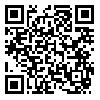BibTeX | RIS | EndNote | Medlars | ProCite | Reference Manager | RefWorks
Send citation to:
URL: http://jhsw.tums.ac.ir/article-1-5855-en.html
2- Professor, Department of Occupational Health Engineering, School of Public Health, Tehran Universairty of Medical Sciences, Tehran, Iran
3- Assocciate Professor, Department of Environmental Management, School of Environment and Energy, Sciences and Reearch Campus, Islamic Azad University, Tehran, Iran
4- Assistant Professor, Department of Occupational Health Engineering, School of Public Health, Qazvin Universairty of Medical Sciences, Qazvin, Iran ,
Introduction: Using diesel generators is necessary for activities like welding in construction sites and it is often accompanied with noise pollution. The aim of this study was to evaluate noise pollution induced by diesel generators in construction activities in one of the districts of Tehran city.
Material and Method: In this descriptive study, 14 construction sites were selected for the evaluation of noise pollution in Tehran, district 4. Background and diesel generators sound pressure level were measured in accordance with BS 5228(2015) and noise guidance in the area around the construction sites. Diesel generators sound pressure level at 4 points and also the audio frequency analysis, one meter away from the device was measured at a random locations around it. TES-1358, Type 2(Taiwan) sound level meter was used to measure sound pressure level and calibration was performed before and after noise measurement. The validated Noise annoyance questionnaire adopted from ISO15666 standard, completed by the residents. T test, correlation and analysis of variance was performed to analyze data using SPSS software ver. 22.
Result: The mean equivalent sound level of diesel generators background noise were respectively 76 ± 4.05 dB(A) and 46.2 ± 1.09 dB(A) around the construction sites. Diesel generators noise around the construction sites was higher than the noise limit (background noise plus 5 dB)(P Value <0.05). The highest (95.3 ± 0.33 dBA) and lowest (90.9 ± 0.63 dBA) average sound pressure level was related to Benz355 and Perkins generators. One-way ANOVA statistical analysis showed significant differences in the average sound pressure level of various diesel generators between the devices (P Value <0.05). The mean sound pressure level among 190 sound monitoring stations in the interior parts of the construction sites were about 81.11 ± 4.6 dB(A). The experienced noise annoyance was evaluated higher than the average by 73.4 percent of residents. Residents’ noise annoyance and noise level around construction sites were significant using Pearson correlation (R=0.486, P value <0.05). Dominant noise frequency and associated sound pressure level of diesel generators were measured 63 Hz and 84.4 dBA, respectively.
Conclusion: Diesel generators noise in the area around the construction sites was higher than the environmental noise limit and it was accompanied with abundant noise annoyance for residents around these construction sites. Therefore, due to the lack of environmental rules related to construction industry noise pollution in Iran, assessment and approving of such rules is essential to reduce noise annoyance in urban areas.
Received: 2018/06/22 | Accepted: 2018/06/22 | Published: 2018/06/22
| Rights and permissions | |
 |
This work is licensed under a Creative Commons Attribution-NonCommercial 4.0 International License. |





